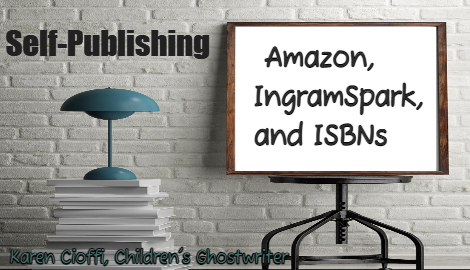Having a self-publishing service, I’m learning a lot. The research is time consuming, but I’m learning. This week, I’m working on Amazon and the new 979 ISBNs, and how it all works with IngramSpark. I found a great group of knowledgeable people at PodPublishing, and they’re super-helpful. A special thanks to Aaron and Scott. There’s a lot involved in self-publishing. If you’re going to attempt it on your own, I suggest you do a lot of research, maybe even team up with someone who has some experience jumping through the hoops to get it right. My most recent dilemma is with Amazon. They’re not allowing my client’s print books that were published through IngramSpark to be available for sale. The paperback cover is on Amazon, but it states, “Temporarily out of stock.” And for the hardcover it says, “Currently not available.” It doesn’t even have the hardcover book cover up. It’s so very frustrating. Possible Reasons 1. Supposedly, the new batch of ISBNs that you can purchase for your books start with the numbers 979. It seems Amazon’s system still has it set for the 978 ISBNs. Amazon is having trouble getting the new numbers to work properly. As an example, here is the ISBN from the paperback I uploaded recently: 979-8-9881233-3-0. The title of the picture book is Shawn’s What-Ifs by Dr. Robin Baweja. This problem has me wondering if Amazon is just finicky and is playing games with books distributed to them from other sources, like IngramSpark. Let me backtrack a moment. Every book distributed for sale needs an ISBN (International Standard Book Number). It identifies your book, and each format of your book needs a unique ISBN. So, the ebook, paperback, and hardcover format will each have their own ISBN. Along with this, you must use the same ISBN for each book format no matter where you’re distributing your book (Amazon, IngramSpark, Smashwords, etc.). 2. The other possible reason is book returns. Brick and mortar retailers always insisted on a returns option. They didn’t want to be left holding the book and cost if a customer returned it. But now it seems all retailers want returns allowed. I’m not sure if it’s the POD printers / distributors initiating this. I’ll talk more about this in another article – hopefully next week. A Remedy I was told the simplest way around this issue is to upload the paperback to Amazon directly, in addition to having it through IngramSpark. If Amazon keeps playing games with the paperback, that’s what I’ll try to do. The problem, though, is Amazon will most likely deny the book stating the ISBN is already in use (on IngramSpark). This has happened to me before. Even before Amazon had a supposed problem with the 979 ISBNs, I always had trouble uploading the same print ISBN to both IngramSpark and Amazon. With all these problems you may wonder why bother publishing through both IngramSpark and Amazon. The Perks of IngramSpark So how it works is IngramSpark is one of the largest aggregators for books. When you publish through them, your book is made available just about everywhere, including Amazon, Barnes and Nobel, brick and mortar bookstores, libraries, and around 4,000 other distributors. This wide distribution network is why most authors use them to publish and distribute their books. The Downside of IngramSpark At least one of the downsides of using IngramSpark is the fees they take are ridiculous. There are times I make around $0.50 on a book sale, and my paperback book, How to Write a Children’s Fiction Book, is listed at $14.99. I contacted them about this and was told it’s all the fees related to discounts, distribution, printing costs, etc. I will have to look into it further. Amazon's Distribution While IngramSpark has one of the largest distribution networks, Amazon has Expanded Distribution. With this feature, Amazon will “make your book available to distributors so booksellers and libraries can find your book and order it.” Amazon will distribute your book to booksellers and libraries, but those entities most likely won’t want to buy from Amazon as Amazon is considered the competition. NOTE: If you publish your book through IngramSpark, you shouldn’t use Amazon’s Expanded Distribution. The Dilemma Every author wants their book to be distributed as far and wide as possible. Up to this point, I’ve been uploading to IngramSpark and Amazon but I’m beginning to realize that I should just publish through IngramSpark. The book will still be available on Amazon, and it might alleviate a lot of headaches. Well, it should be available on Amazon once they figure out how to make books with the 979 ISBNs available. Again, there’s a downside. You’ll make less money publishing through IngramSpark. At least, that’s what’s happening with my nonfiction book. Do you have any suggestions on a simplified workaround for Amazon and the new ISBNs?
I’m a working children’s ghostwriter, rewriter, editor, and coach. I can help turn your story into a book you’ll be proud to be author of, one that’s publishable and marketable. Or, maybe you’d rather do-it-yourself. Check out my book, How to Write a Children’s Fiction Book. Do you have your children’s manuscript already done and need help self-publishing? Click the link to find out how Writers on the Move Publishing can help you. For writing or self-publishing, you can contact me at: kcioffiventrice@gmail.com. Or, you can give me a call at 834---347---6700. (Please leave a message - I'll get back to you as soon as I can.)


